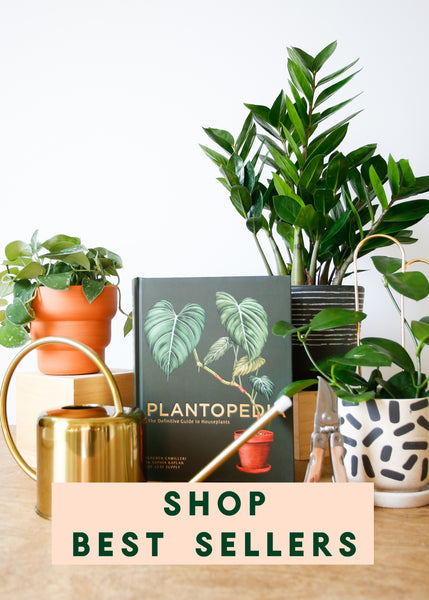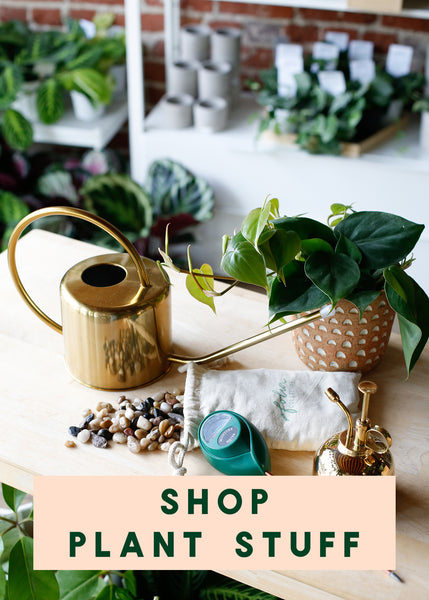Plant Know-How: Sansevieria masoniana (AKA 'Whale Fin' Snake Plant)

In addition to the huge variety of Sansevieria* available (according to the most recent WFO Plant List, there are 200 accepted species/varieties/subspecies of Sansevieria!), something else we love about these easy-going plants is watching them transform from single leaf plantlets into full-sized specimens.
Take this fun species, Sansevieria masoniana- it recently became popular to grow this plant as a single leaf and market it as the 'Whale Fin' Snake Plant, and while it does make for an interesting sculptural plant as a single leaf, over time it develops into a full, and potentially massive plant (like the amazing specimen from our friend Craig Miller-Randle pictured alongside his variegated S. masoniana below). We know some of y'all prefer the single leaf shape (read through for tips on maintaining that form), but we're always awestruck by huge, full pots of this broad leaved beauty!
Like other Sansevieria, S. masoniana is an easy-going plant with fairly straightforward care. Read on to learn how to keep yours thriving!

(Photo courtesy of Craig Miller-Randle)
HOW TO CARE FOR SANSEVIERIA MASONIANA:
Light requirements for Sansevieria masoniana : Bright filtered light is best for all Sansevieria, but they will tolerate lower light levels- at least for a time. In medium or low light, you can expect the plant to lose some leaves, and for colors to be less distinct over time. In lower light leaves will also become less rigid over time as the plant tissue stretches out to maximize how much light the plant can take in. This will be a much more pronounced issue with very large leaved species like S. masoniana. Sansevieria can handle some direct sun as well, but if kept in full sun all day leaves can become bleached-out looking and some areas may get sunburnt.
Watering tips for Sansevieria masoniana: Like other Sanseviera, the 'Whale Fin' should be allowed to dry out all the way to the bottom of the pot between waterings. Sansevieria have fine roots connected to thicker rhizomes- both of which are sensitive to overly wet soil. They also store water in their leaves and rhizomes, so when in doubt- wait another week to water as they tolerate becoming too dry (for short periods of time) much better than they do being too wet. If you need some help knowing how wet or dry your soil is, a moisture meter is a helpful tool that can take out some of the guesswork!
The Best Soil for Sansevieria masoniana: Most Sansevieria are native to arid climates, so chunky, fast-draining soil best mimics their native soil. Our Desert Potting Mix is an excellent choice for Sansevieria, but our Folia Favorite Mix will also work as it provides good aeration and doesn't retain moisture excessively long.
Is Sansevieria masoniana pet-safe? Sansevieria are not pet-safe and can be toxic when consumed by pets. If you're looking for pet-safe plants, be sure to check out the Pet Safe category of the Plant Care Compendium!
How to style Sansevieria masoniana: Younger specimens fit nicely into groupings of Sansevierias other other plants, but can also work well on their own in an interesting planter, or placed in a cluster of decorative objects. As the plant matures, it may need more space than a dense grouping of plants can provide.
Did you know? If you'd prefer to maintain the single-leaf 'Whale Fin' form your plant may have when you first get it, as new leaves form, you can remove them from the mother plant and pot them up on their own. This also makes an easy way to share your plant with others. We find the easiest way to divide Sansevierias is with a clean, sharp knife (like a pocket or garden knife). Make a clean cut, keeping a portion of the rhizome and any finer roots that have formed attached to the leaf you are separating. With roots attached you can immediately pot this offset into soil, keeping soil slightly moister than usual until is has established itself in the new soil.

If you've been looking for a 'Whale Fin', we currently have them in adorable 4" and 5" pots- available in both our Eagle Rock shop and online for shipping!
*The genus Sansevieria was recently folded into the genus Dracaena. We prefer to use the more familiar, and still accepted Sansevieria synonyms, rather than the updated Dracaena names.





